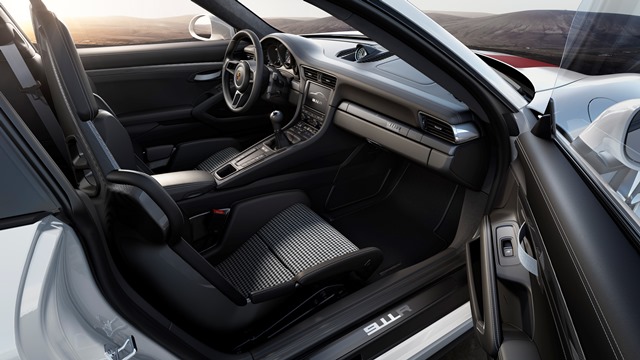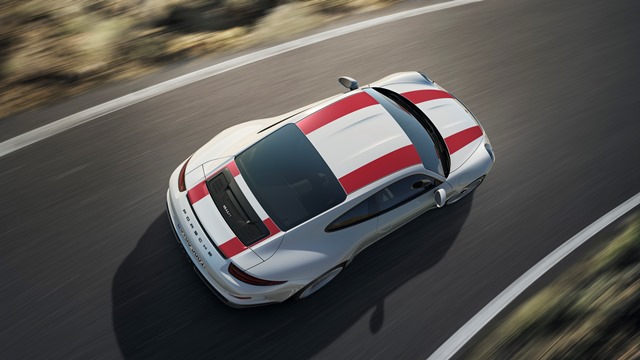GENEVA – One for the purists.
That’s how Porsche succinctly refers to the back-to-the-basics 911 R – a 493-hp rear-wheel-drive variant of its iconic rear-engine coupe conceived around the premise of simple driving engagement rather than all-out lap-time potential.
Revealed at the 2016 Geneva auto show, the stripped-down 2-seat 911 R developed by Porsche’s Motorsport division aims to project all the characteristic feel, response and interaction of Porsche’s earlier race-car-based models, but in combination with a modern-day mechanical package that provides 911 Carrera S-beating performance.
In a move that is sure to bring a smile to the face of traditionalists, the latest member of the 911 family runs the most powerful version the German automaker’s naturally aspirated flat 6-cyl. engine – the same engine used in the 911 GT3 RS.
The car also heralds the return of a manual gearbox to the more sporting end of the 911 lineup in the form of a specially developed 6-speed unit imbued with what Porsche describes as a short-travel action and its own unique ratios.
Inspiration for the new Porsche model comes from the classic 911 R produced in limited numbers as part of a homologation process for Porsche’s sports-car racing program in 1967 and campaigned in events such as the grueling Targa Florio endurance race.

The R in the name denotes the word Racing, and like its celebrated predecessor, the new 911 R relies heavily on lightweight components developed by Porsche Motorsport to help heighten its handling prowess.
The back-to-basics approach applied to the 911 R clearly is evident in its styling. Its carbon-fiber and aluminum body is largely shared with latest 911 GT3, with which it also shares its plastic bumpers and sills.
But while the 911 GT3 runs an adjustable fixed rear spoiler, the 911 R features a retractable spoiler, similar to that found on the 911 Carrera, in combination with a specially developed diffuser element mounted at the rear, giving it a far more reserved appearance.
Classic Porsche logos along the bottom of the doors and twin racing stripes in either red or green complete the retro makeover of the exterior.
Inside the 911 R’s pared-back cabin there are carbon-backed seats with tartan upholstery recalling the design used on the original 911, pull straps for the door openers, an R-specific steering wheel measuring 14.2 ins. (36 cm) in diameter, carbon-fiber trim elements and an embedded aluminum badge denoting the build number.
Weight Cut, Power Punched
Power comes courtesy of the same naturally aspirated 4.0L horizontally opposed direct-injection gasoline engine used in the 911 GT3 RS. The classically configured 6-cyl., positioned at the rear on dynamic engine mounts used to suppress driveline movement and provide more constant weight transfer during cornering, produces 493 hp at 8,250 rpm and 339 lb.-ft. (460 Nm) of torque at as high as 6,250 rpm – figures that hint at a particularly peaky delivery, in keeping with 911s of old.
As part of efforts to provide the new model with some of the characteristic driving traits of its more celebrated forebears as well as to save weight, the 911 R eschews the 7-speed dual-clutch gearbox found in the 911 GT3 RS for a simpler and lighter 6-speed manual boasting a double-declutch function activated by the press of a button.
As tradition dictates, drive is channeled to the rear wheels through a mechanical locking differential.

Among the weight-saving measures are carbon-fiber hood and front fenders instead of the aluminum used on standard 911 models. It also features a magnesium roof structure along with the plastic side windows and rear window from the 911 GT3 RS.
Additional weight savings come in the interior, which uses less sound-deadening material than its road-going siblings. The rear seats, air conditioning system and radio also have been jettisoned. Altogether, the 911 R weighs in at 3,020 lbs. (1,370 kg), 110 lbs. (50 kg) less than the 911 GT3 RS.
This provides the 911 R with a weight-to-power ratio of 6.1 lbs./hp – sufficient, according to Porsche’s official performance claims, to provide it with a 0-62 mph (100 km/h) time of 3.8 seconds and a top speed of 201 mph (323 km/h) at redline in sixth gear.
Underpinning the new 911 is a reworked version of the chassis used beneath the 911 GT3, complete with rear-wheel steer and carbon-ceramic brakes featuring generously dimensioned 16.1-in. (410-mm) discs up front and 15.3-in. (390-mm) discs at the rear as well as a wheel and tire package that mates 20-in. center-lock rims with 245 profile rubber up front and 305 profile rubber at the rear.
Porsche will produce the 911 R in limited numbers alongside other 911 models at its main manufacturing facility in Zuffenhausen, Germany. North American deliveries begin in May.





